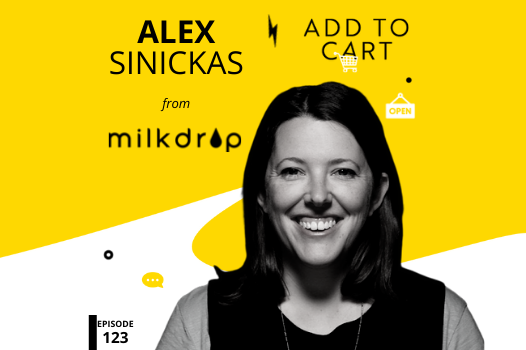In this episode of Add To Cart, we are joined by Alex Sinickas who is the Co-Founder and Engineer at Milkdrop. Milkdrop is changing the way breast pumps feel for women, by redesigning the pump from the nipple up – and as you’ll hear from Alex, they have a much bigger mission at play. Established in 2019, Milkdrop has already attracted funding, won the Amazon Launchpad, worked closely with universities and won government grants. Today Alex talks us through her approach to product prototyping with her engineering background. We also discuss some of the ways Alex and the team are getting information on the size and shape of Australian women’s nipples – which includes getting flashed in public. Just a standard day at work really. And totally unrelated but very cool, Alex tells us about her time as a ski patroller where she had to use dynamite to trigger avalanches.
“It’s crazy, I mean you can’t even show a nipple on Instagram, even if it’s a breast-feeding nipple!”
Alex Sinickas
Questions answered in this episode include…
- How did you go from snow scientist to breast pump designer?
- How did you come up with the sleek brand aesthetic for what is actually a medical device?
- Without an eCommerce background, how did you get up to speed to make eCom your primary channel?
Experience a problem to solve a problem
“I had a baby, and we had trouble feeding, so I couldn’t get a good latch. And so, I ended up on a breast pump. I really wanted to feed her breast milk because I guess that’s the desirable thing to do. And I thought, “Well, I can still do that if I’m using a breast pump, even if I can’t get a good latch.” And so, I ended up on the pump probably six to eight times a day, at least every couple of hours.
And after a few months of that, to be honest, it just got to me and being an engineer I think I could see that it wasn’t necessary. And it just irked me that my breast is soft, why am I putting it against hard plastic when there are so many other materials out there? Especially in the last few years that are appropriate to put against the skin, even broken skin that they’re not cheap, but they’re not so expensive, and they’re hard to work with, but not impossible.
And so, I just felt like whilst I’m grateful that breast pumps exist and I’m grateful to the designers that made them, and they help us feed our babies when we couldn’t otherwise, I just felt like the design could be improved. And so, that’s where it all started.”
The business of avalanches
“I trained in civil and structural engineering, and I worked for a while in investment banking. I was terrible at it, and went back to engineering very quickly. And ended up in natural hazards in Canada and ended up working as a ski patroller. While I was ski patrolling, one of the things that if you were lucky enough to be chosen that morning you would be able to do what they call avalanche control, which is making the mountain safe for people to ski. This is in Canada where they have lots of snow, and steep mountains. And so, you would walk along the ridges, and you would be throwing dynamite sticks over the edge of the ridge to set the avalanches off often, so that they don’t all build up into one big avalanche and make it really unsafe. And that just blew my mind a little bit.
It did get me thinking about the science of snow and stability and how that happens. And so, I ended up studying that and working as an avalanche engineering researcher, and I was looking at how to keep people and infrastructure safe in mountain regions. So, using a lot of probability and statistics, and I guess, one of the things in that whole experience was how to make decisions in uncertain situations. And that really, I know that it’s natural hazards, but it’s not that different.
It’s all design and trying to take the available science and the problem you’re trying to solve and stitch it together through the uncertainty, that’s what engineering is, and trying to make something that’s acceptable for humans and your environment. And that can actually be made and can be made cheaply enough and all of these things. That kind of discipline of engineering is really helpful for business.”
Life-changing feedback
“One of the loveliest, most heart melting stories is hearing from a woman whose mum had bought the cushion for her. And this is thing that you have when you’ve had a baby, and your mum comes up to you and says, “Oh, this is how we did it in our day,” and you’re like, “Oh, come on, it’s different now.” And so, I don’t think she took it seriously. But she was having a dreadful time pumping.
And so, her mum eventually dogged her into trying it, and she did. She was in tears every session, totally distressed, tried the cushion, and suddenly there was no pain, no discomfort. She was able to collect milk. She said that it was the difference between her not breastfeeding her baby, and stopping, and being able to continue, and it just changed her entire outlook, and even her mental state.”
Links from the episode:
Shopify Plus and Peter Sheppard (sponsored)
Signet and Free to Feed (sponsored)
This episode was brought to you by…





